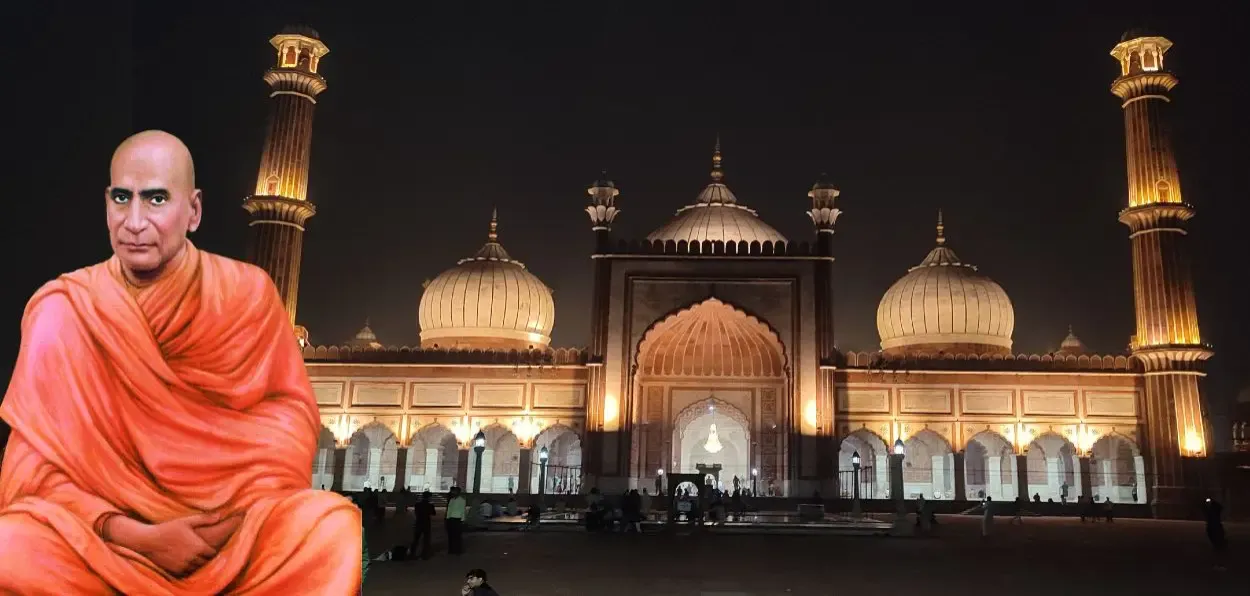
Saquib Salim
A Hindu Sanyasi wearing a saffron robe walks amidst the cheers of “Hindu Muslim ki Jai” (Long live Hindu and Muslim) in Jama Masjid in Delhi during the Friday prayers. The mosque is full. Thousands of Muslims are waiting for this Sanyasi to address them from the pulpit. Hundreds of other Hindus are also allowed inside the mosque.
Does it sound surreal? I am not writing a fantasy. This had happened on 4 April 1919. The Sanyasi was Swami Shraddhanand, the tallest leader of Arya Samaj’s Shuddhi and Gauraksha movements.
After the First World War, the British came up with the Rowlatt Bill which proposed more checks on the right to speech and expression of Indians. The bill was called draconian by the Indian leadership led by M. K. Gandhi (Mahatma Gandhi).
Gandhi and other leaders signed a pledge in February 1919 at Ahmedabad to oppose the bill if made into an act by the British government. The pledge said, “Signatories affirm that in the event of these Bills becoming law and until they are withdrawn we shail refuse civilly to obey these laws and such other laws as the Committee hereafter to be appointed may think fit.” The pledge was signed by Abul Kalam Azad, Ajmal Khan, Lajpat Rai, Motilal Nehru, Mrs. Naidu, Abbas Tayabji, N. C. Kelkar, V. J. Patel, Vallabhbhai Patel, M. R. Jayakar, Jawaharlal Nehru, Gangadhar Rao Deshpande, Mr. Sobani, Jamnalal Bajaj, M. S. Aney, Dr. Ansari, Khaliquzzaman, Abdul Bari, Rajagopalachari, Jatindra Lal Bannerji, Rajendra Prasad, Hasrat Mohani, Yaqub Hasan, Dr. Moonje and Jairamdas Daulatram.
While in other parts of the country, the day chosen for the Satyagraha after the bill had been passed was 6 April, in Delhi Satyagraha was held on 30 March. The Satyagraha Sabha, formed on 7 March 1919, in Delhi, had fourteen leaders. These included Dr. Ansari (President), Munshi Ram popularly known as Swami Shraddhanand, Hasrat Mohani, Dr. Abdur Rahman, Shankar Lal, Shiv Narain Haksar, Miss Gmeiner, Shuaib, Indra (son of Swami) and his wife and others.
Among them, Swami Shraddhanand, Mahmud Shuaib, and Abdur Rahman were the main organizers of the Satyagraha on 30 March 1919. The action plan was publicized as:
“( 1 ) The 30th of March should be celebrated as a day of mourning.
(2) Beginning from the night of March 29th all should fast till the night of 30th March.
(3) After finishing all other daily duties, should sit in a quiet place and pray to the Parmatma that He might give us the power of endurance, guide our sarkar in the path of rectitude, and put an end to the troubles of Mother Bharat.
(4) Closing all businesses and shops, etc. should spend the day in wishing well for the country, in reforming his mind, and in philanthropic work.
(5) Every woman, man, and child should attend the evening meeting at 5 o'clock. ”
The day became one of the bloodiest in the history of Delhi since 1857. It also proved to be a warning from the British government to the Indians and two weeks later they carried out a massacre at Jallianwala Bagh in Amritsar.
The British Police and Army fired upon Satyagrahis at the Delhi Railway station killing more than a dozen at 2 pm. As the crowd moved towards the clock tower in Chandni Chowk, the police again killed several. More than 50 peaceful unarmed Satyagrahis were killed in Delhi by the British police and army.
Swami Shraddhanand on hearing that machine guns had been used at the Satyagrahismarched with thousands of people from Chandni Chowk to Clock Tower. The British army halted him and pointed guns to fire. Swami narrated the incident in front of the inquiry commission.
Swami wrote, “When we were nearing the Clock- Tower, Gurkhas were in the middle of the road, in double file facing both ways. On seeing us they marched to the right foot-board. We thought they had left the road to enable us to proceed but when we reached near them, a rifle was fired into the crowd. There was a stir and a deep tone of resentment among the crowd. But I asked all to halt and they obeyed. In my sanyasi dress, I went up to the footpath alone and asked the Gurkhas why they were firing on innocent peaceful people. Two rifles were immediately pointed at me and they began saying in a very insolent tone tum ko chhed denge (we will pierce you). I stood quietly before them and said. "Main khara hun, goli maro (I am standing, fire). At once eight or ten more rifles were aimed at my breast and insolent threats went on.”
The Satyagrahis killed were both Hindus and Muslims. On 4 April it was decided to have special prayers on Friday for the Shaheeds (martyrs). Swami Sharddhanand and several Hindus were especially invited inside the Jama Masjid. He delivered a lecture on Hindu Muslim unity.
On 17 April C. A. Barron , C.I.E. , I.C.S. wrote to Sir J. H. DuBoulay, K.C.I.E. , C.S.I. , I.C.S., “On the 4th the Jama Masjid prayer meeting passed off without any disturbance, but was remarkable for the fact that a number, of Hindus were invited into the mosque and the Arya Samajist Munshi Ram (Swami Shraddhanand ) was allowed to address the assembly from the pulpit.”
R. C. Jeffreys, Superintendent of Police, C.I.D. reported, “The Swami was permitted to speak from the pulpit in the Jama Masjid and this unprecedented situation led him to urge the people to show no fear if half their number was slaughtered instead of 40 or 50.”
ALSO READ: Is mixed housing a solution to growing Hindu-Muslim chasm?
In the next few days, the British government would fire upon Indians at several places including Jallianwala Bagh, Ahmedabad, Lahore, etc. They used air force on the protestors at several places like Gujranwala.
